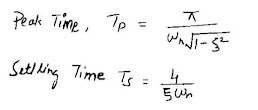This section of Control Systems Multiple Choice Questions and Answers (MCQs) focuses on “ Time-domain analysis ”. These MCQs are very ...
This section of Control Systems Multiple Choice Questions and Answers (MCQs) focuses on “Time-domain analysis”. These MCQs are very fruitful for the preparation of University exams, Engineering exams, and various competitive exams.
1. The time response of a control system consists of :
Explanation:- The time response of the control system is divided into two parts :(a) Transient response and (b)Steady-state response.
2. The steady-state response of the control system reveals about:
Explanation:- The steady-state response of the control system reveals about the accuracy of the control system while the Transient state response of the system gives an indication about the speed of the control system.
3. The system having a small time constant is :
Explanation:- Speed of the system is inversely proportional to the time constant of that system. So for the small time constant, the system is fast and for the large time constant system is sluggish or slow.
4. The Time required for the response to reach 50% of the final value in the first attempt is known as
Explanation:- Delay time: Time required by the response to reach 50% of the final steady-state value.
Rise time: Time required by the response to rise from 10% to 90% of the final steady-state value.
Peak time: It is the time required by the response to reach the first peak of the time response.
Settling time: It is the time required for the response to reach and stay within the specified range(2% to 5%)of its final value.
5. The transient response of a control system:
Explanation:- The transient response goes to zero as time becomes large. The response which remains after the transient has died out is called a steady-state response, which indicates the final accuracy of the system.
6. The speed of a critically damped system (ζ = 1) is faster than the overdamped system(ζ > 1).
Explanation:- The speed of a critically damped system (ζ=1) is faster than the overdamped system(ζ>1) but slower than the underdamped system(ζ).
7. For the characteristic equation s2 + 7s +20 =0 , the damping ratio(ζ) and natural frequency(Wn) respectively are:
Explanation:- Compare the given characteristic equation with the general form of the characteristic equation of second-order system s2 +2 ζ Wn s +Wn2
8. When a second order control system is subjected to a unit step input ,the value of ζ=0.5 and Wn=6rad/sec. Determine the peak time and settling.
Explanation:- Use the formula for peak time and settling time as given below:
9. In a second-order system when 0< ζ < 1 then the poles are :
Located in the right half of s plane.
Complex conjugate of each other.
Explanation:-When 0< ζ < 1 then the poles are complex conjugate of each other. When ζ >1 then poles are real and unequal. When ζ = 1 then poles are real and equal.
10. The normalized difference between the peak of the time response and the steady-state output is known as:
Explanation:-Peak(maximum) overshoot shows the normalized difference between the peak of the time response and the steady-state output.




